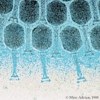Strangely, the phrase “orders of magnitude” featured in a visitor’s search efforts while browsing the sciencebase site. Unfortunately, other than using the phrase myself in the context of, for instance: “the amount of greenhouse gases emitted by human activities is several orders of magnitude smaller than those emitted by natural processes”. I did not actually have a definition of orders of magnitude on the site. Until now. So here goes:
The order of magnitude is the scale of any given amount where each class contains values of a fixed ratio to the class preceding it. The ratio most commonly used is 10. For example, a kilogram is three orders of magnitude bigger than a gram.
In the greenhouse gas instance cited above, the phrase “orders of magnitude” is simply being used colloquially and can apply in many situations, such as the volume of water in the Pacific Ocean is many orders of magnitude greater than that contained in Lake Michigan. To give a more solid example, one might say “An order of magnitude difference between two values is a factor of 10. For example, the mass of the planet Saturn is almost 100 times that of Earth, so Saturn is two orders of magnitude more massive than Earth.
Orders of magnitude are not always on the decimal scale. For instance, the difference in size between a megabyte and a gigabyte is three orders of magnitude, but the multiplier is 1024 rather than 1000. Please correct me if I’m wrong on that, I guess you could define a single order of magnitude her as being based on 1024 rather than “10”.
More on order of magnitude here.
 Researchers have developed several tools to help them exploit the underlying chemistry of genomics, while novel chemistry has enabled faster, parallel sequencing methods that not only accelerate genomic research but also cut costs. The very same techniques allow sex chromosomes and complete genomes to be decoded faster and more cheaply than ever before.
Researchers have developed several tools to help them exploit the underlying chemistry of genomics, while novel chemistry has enabled faster, parallel sequencing methods that not only accelerate genomic research but also cut costs. The very same techniques allow sex chromosomes and complete genomes to be decoded faster and more cheaply than ever before. Solid state NMR is unlocking the secrets of compounds found in natural membranes from frogs’ legs to human lungs that could lead to an entirely new class of antibiotic drugs. The compounds in question are antimicrobial peptides (AMPs) and they have been detected in every living creature studied so far. AMPs act as a first line chemical defence system in a huge range of organisms and could provide a novel approach to defeating drugs resistance in bacteria.
Solid state NMR is unlocking the secrets of compounds found in natural membranes from frogs’ legs to human lungs that could lead to an entirely new class of antibiotic drugs. The compounds in question are antimicrobial peptides (AMPs) and they have been detected in every living creature studied so far. AMPs act as a first line chemical defence system in a huge range of organisms and could provide a novel approach to defeating drugs resistance in bacteria. Both the UK and US national diabetes organizations have a risk test available for anyone worried about diabetes risk. Read the rest of this post and then take the tests and let me know how you get on.
Both the UK and US national diabetes organizations have a risk test available for anyone worried about diabetes risk. Read the rest of this post and then take the tests and let me know how you get on. Chemists go veggie
Chemists go veggie The faint glow from a single molecule combined with a stretch from “magnetic tweezers” could help scientists get a grip on how viruses that infect bacteria, so-called bacteriophages pack up their DNA. The research could lead to a resurgence of interest in the West for a potent treatment for infection that uses
The faint glow from a single molecule combined with a stretch from “magnetic tweezers” could help scientists get a grip on how viruses that infect bacteria, so-called bacteriophages pack up their DNA. The research could lead to a resurgence of interest in the West for a potent treatment for infection that uses  No, it’s not some kind of deviant gorillas in the mist story, apparently, millions of years ago our ancestors picked up pubic lice (crabs) either by sleeping in gorilla nests (without the gorilla) or through eating our silver-backed cousins. David Reed and colleagues at the University of Florida publish details of their findings today in BMC Biology journal.
No, it’s not some kind of deviant gorillas in the mist story, apparently, millions of years ago our ancestors picked up pubic lice (crabs) either by sleeping in gorilla nests (without the gorilla) or through eating our silver-backed cousins. David Reed and colleagues at the University of Florida publish details of their findings today in BMC Biology journal.